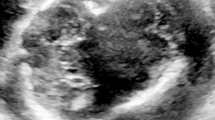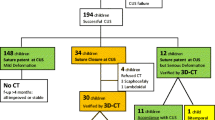Abstract
Introduction
The aim of our study was to assess the utility and reliability of magnetic resonance imaging (MRI) in antenatal diagnosis of craniosynostosis.
Methods
We retrospectively reviewed the MRI examinations of the head of 15 fetuses requested over a period of 11 years on the basis of sonographic suspicion of craniosynostosis. The postnatal diagnosis was available for 14 neonates.
Results
No termination of pregnancy was performed. There were four neonates with sporadic multisuture craniosynostoses, three of which were syndromic, including one Crouzon and one Pfeiffer syndrome. Eight neonates were normal, two showed cranial vault deformities without synostosis, and one was lost to follow-up. MRI showed a high predictive value for craniosynostosis, as there were no false-negative or false-positive diagnoses. However, the severity of the abnormalities were underestimated in two neonates.
Conclusion
We suggest that prenatal MRI has diagnostic value when synostosis is suspected on ultrasonography. Moreover, MRI is accurate in the detection of associated brain abnormalities, which is an important prognostic issue in this diagnosis. Prenatal diagnosis of craniosynostosis is difficult and could benefit from three-dimensional ultrasonography and three-dimensional CT.




Similar content being viewed by others
References
Delahaye S, Bernard JP, Renier D, Ville Y (2003) Prenatal ultrasound diagnosis of fetal craniosynostosis. Ultrasound Obstet Gynecol 21(4):347–353
Benacerraf BR, Spiro R, Mitchell AG (2000) Using three-dimensional ultrasound to detect craniosynostosis in a fetus with Pfeiffer syndrome. Ultrasound Obstet Gynecol 16(4):391–394
Nazzaro A, Della Monica M, Lonardo F et al (2004) Prenatal ultrasound diagnosis of a case of Pfeiffer syndrome without cloverleaf skull and review of the literature. Prenat Diagn 24(11):918–922
Blaumeiser B, Loquet P, Wuyts W, Nothen MM (2004) Prenatal diagnosis of Pfeiffer syndrome type II. Prenat Diagn 24(8):644–646
Bernstein PS, Gross SJ, Cohen DJ et al (1996) Prenatal diagnosis of type 2 Pfeiffer syndrome. Ultrasound Obstet Gynecol 8(6):425–428
Gorincour G, Rypens F, Grignon A et al (2005) Prenatal diagnosis of cloverleaf skull: watch the hands! Fetal Diagn Ther 20(4):296–300
Ghi T, Perolo A, Banzi C et al (2002) Two-dimensional ultrasound is accurate in the diagnosis of fetal craniofacial malformation. Ultrasound Obstet Gynecol 19(6):543–551
Itoh S, Nojima M, Yoshida K (2006) Usefulness of magnetic resonance imaging for accurate diagnosis of Pfeiffer syndrome type II in utero. Fetal Diagn Ther 21(2):168–171
Pooh RK, Nakagawa Y, Pooh KH, Nakagawa Y, Nagamachi N (1999) Fetal craniofacial structure and intracranial morphology in a case of Apert syndrome. Ultrasound Obstet Gynecol 13(4):274–278
Hansen WF, Rijhsinghani A, Grant S, Yankowitz J (2004) Prenatal diagnosis of Apert syndrome. Fetal Diagn Ther 19(2):127–130
Mahieu-Caputo D, Sonigo P, Amiel J et al (2001) Prenatal diagnosis of sporadic Apert syndrome: a sequential diagnostic approach combining three-dimensional computed tomography and molecular biology. Fetal Diagn Ther 16(1):10–12
Boog G, Le Vaillant C, Winer N et al (1999) Contribution of tridimensional sonography and magnetic resonance imaging to prenatal diagnosis of Apert syndrome at mid-trimester. Fetal Diagn Ther 14(1):20–23
Skidmore DL, Pai AP, Toi A, Steele L, Chitayat D (2003) Prenatal diagnosis of Apert syndrome: report of two cases. Prenat Diagn 23(12):1009–1013
Ferreira JC, Carter SM, Bernstein PS et al (1999) Second-trimester molecular prenatal diagnosis of sporadic Apert syndrome following suspicious ultrasound findings. Ultrasound Obstet Gynecol 14(6):426–430
Barkovich AJ (2000) Pediatric neuroimaging. Lippincott Williams & Wilkins, Philadelphia, pp 360–369
Krakow D, Santulli T, Platt LD (2001) Use of three-dimensional ultrasonography in differentiating craniosynostosis from severe fetal molding. J Ultrasound Med 20(4):427–431
Robson CD, Barnewolt CE (2004) MR imaging of fetal head and neck anomalies. Neuroimaging Clin N Am 14(2):273–291
Ruano R, Molho M, Roume J, Ville Y (2004) Prenatal diagnosis of fetal skeletal dysplasias by combining two-dimensional and three-dimensional ultrasound and intrauterine three-dimensional helical computer tomography. Ultrasound Obstet Gynecol 24(2):134–140
Conflict of interest statement
We declare that we have no conflict of interest.
Author information
Authors and Affiliations
Corresponding author
Rights and permissions
About this article
Cite this article
Fjørtoft, M.I., Sevely, A., Boetto, S. et al. Prenatal diagnosis of craniosynostosis: value of MR imaging. Neuroradiology 49, 515–521 (2007). https://doi.org/10.1007/s00234-007-0212-6
Received:
Accepted:
Published:
Issue Date:
DOI: https://doi.org/10.1007/s00234-007-0212-6




